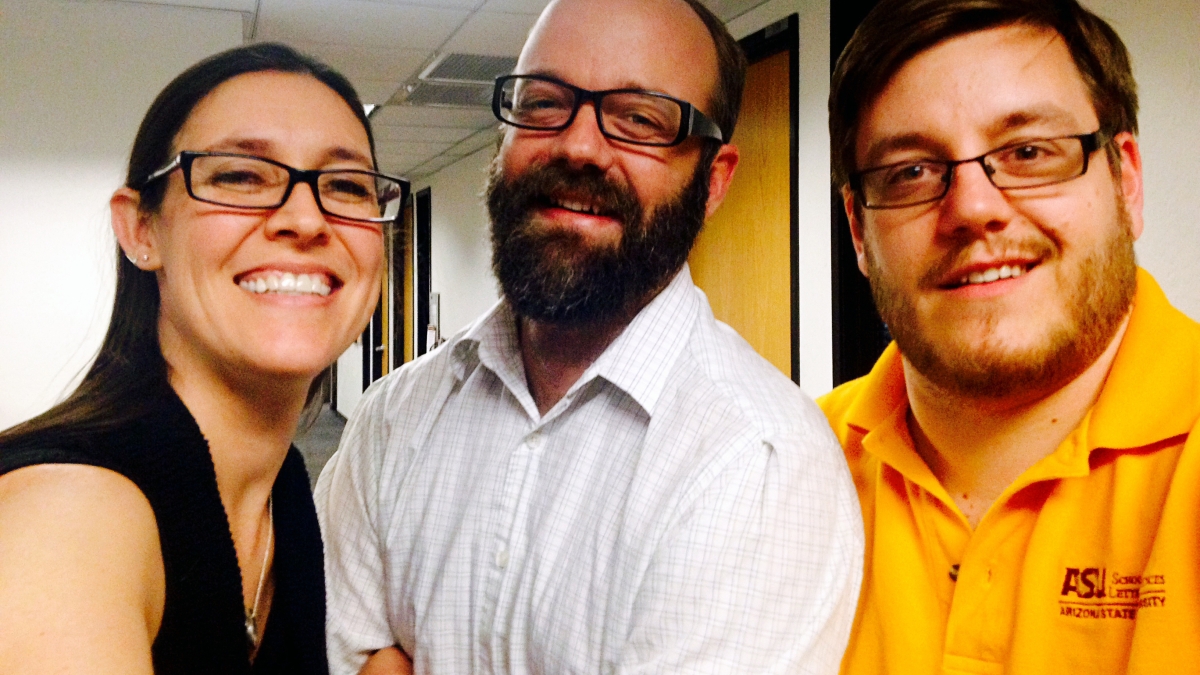Innovative course design shapes confident writers at ASU

We learn to write by writing.
For students in the “Stretch” first-year composition sequence on ASU’s Downtown Phoenix campus, becoming proficient, confident writers means making writing a daily habit and getting comfortable with many of the technologies and tools that are available to reach audiences today.
The innovative course redesign that makes this possible was led by Mark Haunschild, instructor of English in the School of Letters and Sciences and coordinator of the Stretch Writing Program on the Downtown Phoenix campus.
The work of Haunschild and his team was recognized with one of two 2014 ASU Faculty Achievement Awards for Excellence in Curricular Innovation. The awards were presented to Haunschild and Cronkite assistant dean Mark Lodato by ASU President Michael Crow and Provost Robert Page Jr. on April 18.
The award is made for curricular innovations at ASU that meet the highest standards of the discipline or profession. In nominating Haunschild for the award, Barbara Lafford, head of the Languages and Cultures faculty in the School of Letters and Sciences, praised the team’s dedication to improving student learning outcomes and their meticulous attention to student feedback throughout the redesign.
Students in the Stretch program fulfill their ASU Introduction to Academic Writing requirement across two semesters, in WAC 101 and ENG 101 – ideally with the same teacher and cohort of students.
“We know this approach increases student retention as well as performance,” Haunschild says. “It allows for more writing practice, more socialization in academic writing, and builds the student’s academic self-image and confidence.”
In 2010 Haunschild and fellow writing instructor James Wermers, the Digital Humanities course manager in the School of Letters and Sciences, began informally sharing their teaching ideas and assignments with each other.
“We had similar approaches to teaching, and both of us enjoy working with the student populations in ASU student success and transition programs,” Haunschild says. “We felt we could be planning better assignments by working together.”
A year later, instructor Shillana Sanchez joined the School of Letters and Sciences working group. By then, the team realized they weren’t just collaborating, but redesigning curriculum.
“We were very much driven by best practices in the field of writing studies and a ‘let’s stop teaching like it’s 1992’ mindset,” observes Wermers. “We wanted to give students the chance to develop the writing confidence and digital literacy they’ll need in other courses and beyond ASU.”
#fearlesslearners
To help build students’ confidence and acclimate students to the university learning environment, Haunschild and team have designed a lucid, easy-to-navigate Blackboard course shell consistent across sections and teachers. Learning goals are transparent and ever-visible – easy for students to keep always top-of-mind.
“We also coded the module pages to make them scalable and easily accessible on whatever device a student might be using, such as a phone or tablet,” Haunschild explains.
Students are immediately and continually engaged in the writing process and in electronic environments as they discuss and formulate ideas, then draft, revise and give feedback to peers. Quizzes along the way help students gauge their learning and self-progress.
“Students don’t have the ability to put things off – there’s no way to wait weeks and then dash off an essay due the next day,” he says.
The student writing outcomes have been terrific, as reflected in the quality and quantity of writing in the learning portfolios.
In the learning portfolio, students take the essays they’ve completed, reformat them for an online reader and write a final essay with writing advice to incoming Stretch students about the skills they’ll need to master in the course.
“So at the end of English 101, they’re essentially producing a handbook of tips for other beginning writers, rather than just telling me, the instructor, what they learned,” says Sanchez. “They’re talking to a real audience with real needs.”
Students upload these portfolios to the Google sites they create the first day in Stretch, ultimately producing a complete website showcasing their work.
Sanchez says students are invariably astounded at the amount and the quality of work they’ve completed across the two semesters.
“Most have written more than 100 pages of new content – whereas portfolios under the old design were 40 pages on average,” she notes.
Last week, a student in class said to Sanchez, "Wow. It didn't seem like that much work!"
“The scaffolding and activities of the redesign have allowed this to happen,” she explains. “Prior to the redesign, we were asking students to complete isolated tasks, individual writings, research out of context.
“With the redesign,” she continues, “students are able to make connections where they otherwise would not have, to create multiple layers of composition that inform other layers, and see the in-depth and complex process that is writing.”
While some students may enter Stretch feeling tentative about their ability to succeed, Haunschild says the program “creates students who have no fear of reaching out for resources on campus. They know there are limits to studying in isolation and that effective writers need feedback.
“Our Stretch participants have gone on to be employed on campus as tutors or instructional assistants, to found student clubs, to be student body president! There are all kinds of success stories,” he notes.
“The emphasis throughout the program is on gaining rhetorical awareness. Not on a particular form of writing, like lab reports or poetry, but teaching students to analyze the situation,” continues Haunschild. “Who is my audience? What is my task? That’s the kind of ‘far learning’ that serves someone well throughout their life.”
Haunschild, Sanchez and Wermers invite faculty and others who might want to learn more about the Stretch writing program redesign at ASU's Downtown Phoenix campus to get in touch with them directly.